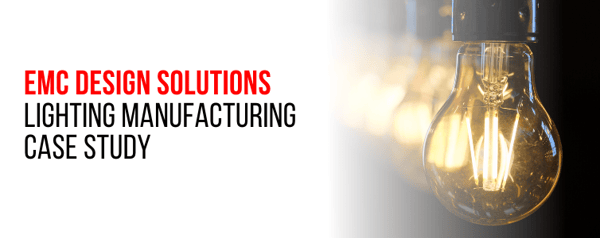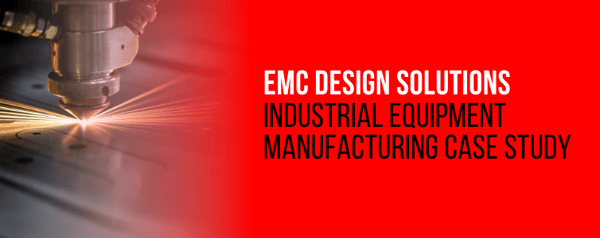RESOURCES
EMC Compliance Case Studies
Designing for EMC compliance can be extremely difficult as many dynamic variables must interact to provide a “clean”, upfront design. There are, however, a number of good EMC design practices that can dramatically reduce the level of pain associated with EMC compliance. A key consideration for cost-effective EMC compliance is for manufacturers to adopt an approach similar to safety compliance, and allow for EMC consideration during product design and development. It is often expensive to leave EMC as the last task to be performed before a product is introduced to the market.
The EMC development cycle is somewhat iterative in that solutions for conducted emissions usually influence the radiated emissions and frequencies. Since EMI compliance is not exactly a product feature and has little perceived value, it is not always established initially as an essential design criterion.
Common EMI/EMC Compliance Misconception
Manufacturers are passing the EMC compliance responsibilities to their component suppliers, believing that if all the components meet the EMC directive, the end product will be compliant. Some also believe this relieves the final product manufacturer of its responsibilities while reducing costs.
It’s not always true that if only pre-tested compliant components are used, that the end product will automatically comply. In other words, CE + CE + CE does not always equal CE, and even when it does, this approach is not the most cost-effective and efficient way of demonstrating compliance with the EMC directive.

EMC Design Solution for Lighting Manufacturer Case Study
Astrodyne TDI was approached by a lamp manufacturer to test and design an EMI filter for a fluorescent lamp using standard Off-The-Shelf electronic ballast, with the product needing to meet a stringent EMI requirement imposed by the end-user. After designing a filter to work with the electronic ballast, the system worked efficiently and met the required EMI standards, so the manufacturer began sales with the product.
Within a few months the customer, exercising good business practices, sent their product to a lab to have it re-tested. During this standard re-test, the product failed to meet the initial EMI requirements. Surprised by this result, both teams went to work trying to uncover the source of the problem by starting with the first question – had anything changed?
After an extensive review of all of the components and wiring configuration, it was discovered that the electronic ballast supplier had changed one of the main components in the ballast PC board assembly with an equivalent part more readily available in the market. Because the electronic ballast was a standard part, it was at the supplier’s discretion to replace any component as long as it still met the original specification, without notifying their customers. The EMI test results revealed that the emissions generated by the ballast with the replacement part were far higher than the previous part, which was EMC compliant. To prevent this problem from occurring again in the future, Astrodyne TDI proposed a new solution in which they would design an integrated electronic ballast and EMI filter in one package.
The new EMI/EMC filter design approach ensured that if Astrodyne TDI controlled the electronic ballast and filter, they could be solely responsible for the EMI performance of the whole assembly. The new integrated EMI/EMC filter and electronic ballast design resulted in a smaller more compact product, generating less production time and more cost savings. This solution proved to be an excellent investment for the company and its product.

EMC Design Solution for Industrial Equipment Manufacturing Case Study
Astrodyne TDI was approached by an industrial equipment manufacturer at the beginning of their product development, to assist with the development of an EMI compliant speed control for a portable motorized vibration tool. The requirements for the control were:
- Single board solution
- Speed regulation of a 3hp universal motor to 10,000 RPM
- Maintain control under any input voltage from 90VAC to 250VAC
- Safety standard compliance for UL, cUL, and IEC
The combined requirements demanded that the EMI filter design lived within the control board. In order to keep costs as low as possible, Astrodyne TDI chose a microcontroller-based Triac phase-cut drive. The need for the board to fit into an unusual space in the product enclosure made this project especially challenging. By being brought in on the front-end of this product’s design, Astrodyne TDI was able to make a board that fit the space, and its design has been highly successful. The best and most cost-effective approach for component manufacturers is to apply effective EMC practices in the initial design and development of their products. This will ultimately assist the end-product manufacturers in obtaining final EMC compliance in the most economical manner.
During the development of the filter for this customer, the following knowledge was critical – SCR’s and Triacs are used to regulate the voltage and therefore the current flowing into a load from the AC supply. The RMS voltage supplied to the motor can be controlled by the firing angle of the Triac. These devices can generate very high levels of EMI towards the line and load. The maximum level of interference is generated when the phase angle is around 90 degrees (usually around half speed) when the voltage is chopped at its peak. The interference generated is broadband and differential mode in nature with the highest levels at the low end of the frequency spectrum (from 150kHz to 750 kHz).
Controllers containing clocks, oscillators or any electronic switching devices will generate EMI emissions. They tend to be designed (or overdesigned) with fast rise times. To reduce the potential for high levels of EMI radiation, the clock rises time and power level should be reduced as much as is practical. Select a clock with a fast enough rise time to do the job, not the fastest rise time available.
The traces on the PC board are the medium of propagation of EMI. These emissions, which radiate from the traces, are generally in the form of common-mode noise. The typical trace inductance on a PC board is 7.5nH per cm. At 100 MHz this translates to an impedance of approximately 5Ω per cm. Therefore, the longer the PC board traces, the longer the antenna and the higher the potential for EMI radiation.
How to Ensure EMC Compliance?
Manufacturers should not expect that taking off the shelf components and pairing them with custom parts in order to provide an EMI solution is enough to ensure compliance for their product throughout the lifetime of its production. There needs to be an understanding that any change in a component, regardless of how minor, can affect the EMI performance of their product in the future. With the end-user being responsible for the compliance of their products, it is highly recommended to have products tested regularly to account for any possible changes and to discover any potential problems as early as possible.
Lack of in-house EMC expertise makes it advisable for design engineers to confer with an EMI filter specialist who can assist with subsystem level testing and development of cost-effective EMC solutions. Transient voltage suppressors (MOV’s), EMI filters and careful selection of components and board layout can help eliminate most immunity problems. Experience indicates that for most electrical product manufacturers, EMC is not a core competency.
Astrodyne TDI can provide you with the necessary EMC knowledge to make informed decisions that will help meet the challenge of complying with EMC standards as cost-effectively as possible. For more information on Astrodyne TDI EMI filters and power supplies, please contact our team or request a quote.

